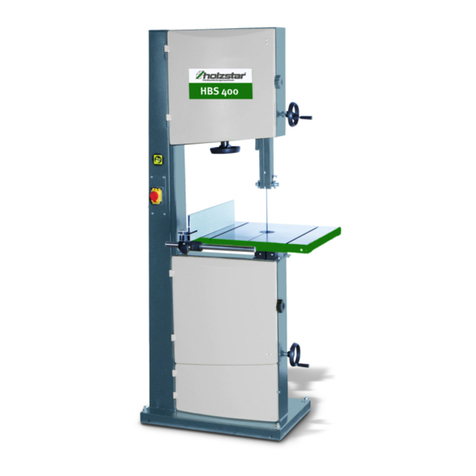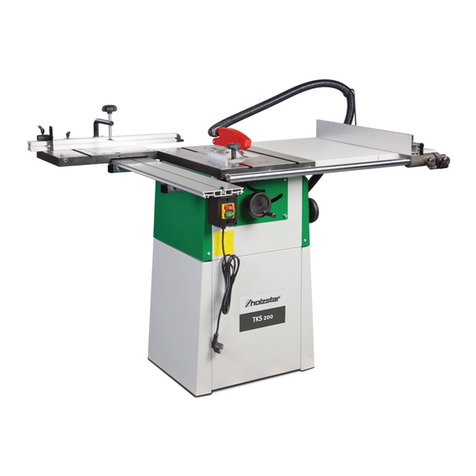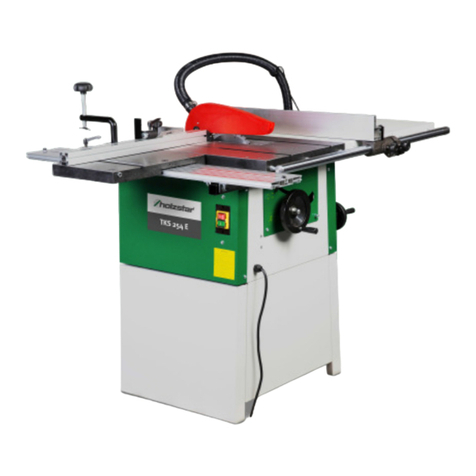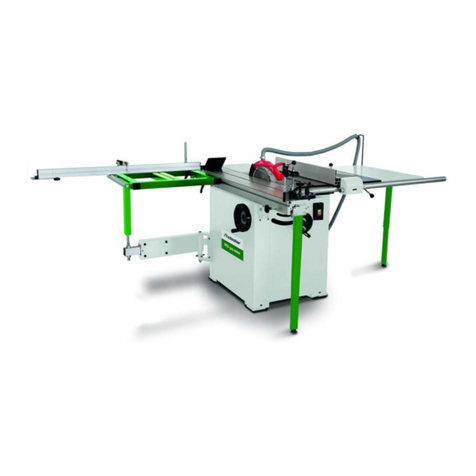
6 TKS 316 E | Version 1.02
Safety
2.5 Safety signs on the Table saw
The following safety signs are applied on the table saw
(Fig. 1), which need to be observed and followed.
Fig. 1: Safety signs
If safety labels on the machine are damaged or missing,
this can cause errors, personal injury and material da-
mage. The safety symbols attached to the machine must
not be removed. Damaged safety symbols must be re-
placed immediately.
As soon as the signs are not clearly visible and compre-
hensible at first glance, the machine must be stopped until
new signs have been attached.
2.6 Safety devices
Riving knife
The riving knife prevents a workpiece from being caught
by the rising teeth and pushed against the operator. The
splitting wedge must always be mounted during opera-
tion.
Blade guard
The blade guard protects against accidental contact with
the saw blade and flying chips. The blade guard must al-
ways be installed during operation.
Push stick
The push stick serves as an extension of the hand and
protects against accidental contact with the saw blade.
Always use the push stick if the distance between saw
blade and rip fence is less than 120 mm.
2.7 General safety instructions
Please note the following:
-
Use the guards and secure them securely. Never work
without guards and get them working.
- Always keep the table saw and its working environment
clean. Ensure adequate lighting and ventilation.
- The table saw must not be modified in its design and not
used for any purpose other than the operations foreseen
by the manufacturer.
- Never work under the influence of concentration-disturb-
ing illnesses, fatigue, drugs, alcohol or medicines.
- Check the function and presence of the safety devices
daily before starting the machine.
- Keep children and not with the table saw. Familiar people
away from their work environment.
- Eliminate disturbances that affect safety immediately.
- Before each use, make sure that no parts of the table saw
are damaged. Damaged parts must be replaced immedi-
ately to avoid any danger.
- Do not overload the table saw! You work better and safer
in the specified performance range.
- Do not wear watches, rings or other jewelry and roll your
sleeves backwards before working with the table saw.
- Do not use the machine in hazardous areas or near flam-
mable liquids and gases.
- Do not touch the power plug with wet hands.
- After switching off the machine, let the extraction system
run for another 3-4 seconds and then switch it off. The re-
sidual dust is sucked out, as required by the Hazardous
Substances Ordinance. This saves electricity and re-
duces noise. Turn on the exhaust system only while the
machine is running.
- Do not switch off or remove the extraction system or dust
extractor while the machine is running.
- Keep the soil around the machine clean and free of saw-
dust and oil to avoid the risk of tripping or slipping.
- Only use original spare parts and accessories to avoid
possible dangers and accident risks.
- Basically, the workpieces to be machined must be free of
foreign bodies such as nails or screws.
- When working on the machine, the use of ear protec-
tion (headphones, earmuffs, etc.) is required.
- Check the correct rotation of the saw blade before ope-
rating the machine.
- Only start cutting when the saw blade has reached full
speed.
- Do not use any lateral pressure to stop the rotating saw
blade.
- ake sure that the workpiece can not move or slip
when cutting round pieces.
- Use suitable table extensions and support aids for
hard-to-handle workpieces.
WARNING!
Read all safety instructions and instructions. Failure
to comply with the Safety instructions and instructions
can electric shock, fire and / or heavy Cause injury.
Retain all safety instructions and instructions for the
future.





































